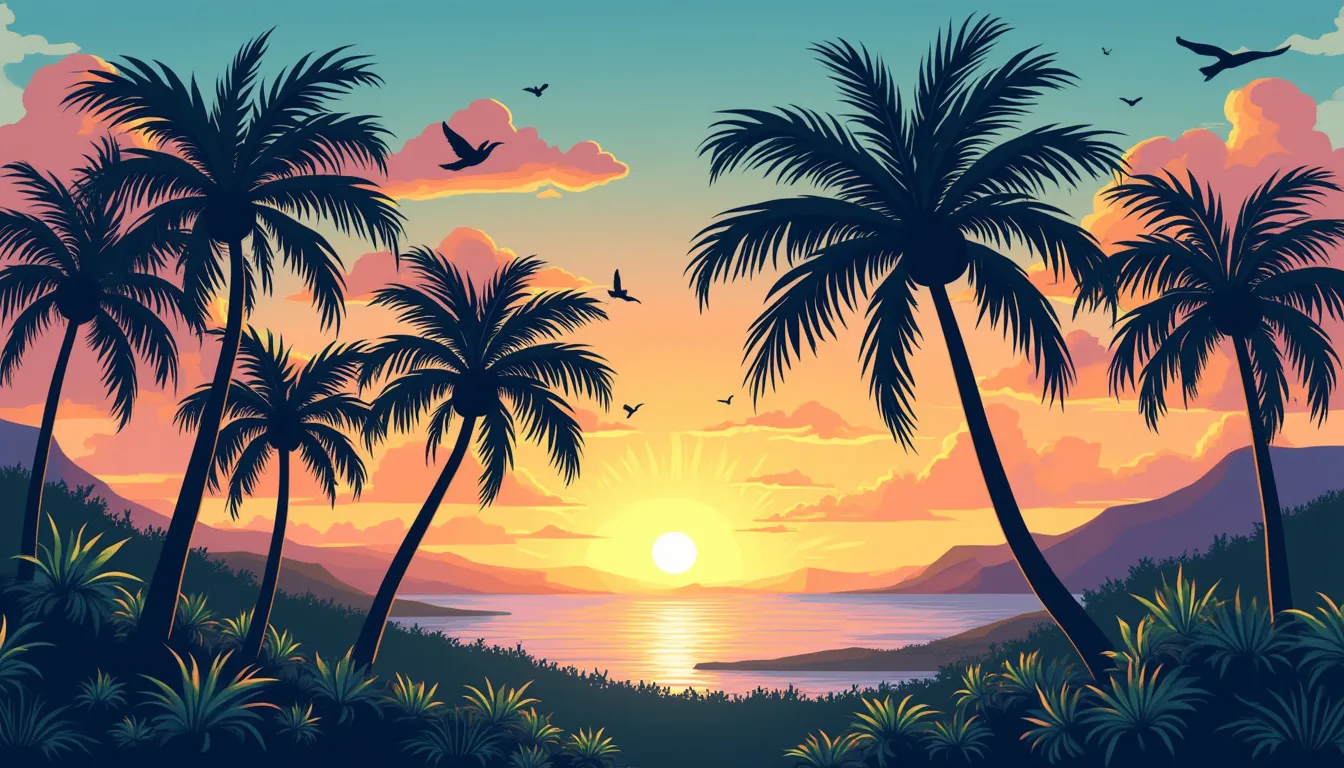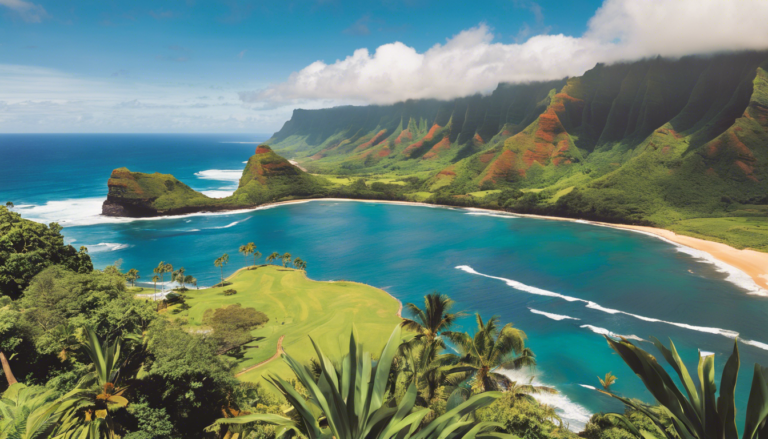Nestled in the heart of the Pacific, Hawaii stands as a quintessential representation of tropical elegance and natural beauty. Often depicted with sun-kissed beaches, lush landscapes, and vibrant sunsets, the islands are frequently associated with their iconic palm trees. But are there palm trees in Hawaii? The answer is a resounding yes. These majestic trees are not only present but are integral to the Hawaiian narrative, contributing to both its scenic and cultural tapestry in a profound way. From swaying gently in the balmy breezes to providing shelter and sustenance, palm trees are an emblematic presence in Hawaii’s diverse ecological melange. Their towering forms and feathered fronds are woven into the very fabric of the islands, symbolizing their identity as a paradisiacal destination. This article delves into the types of palm trees that grace Hawaii and explores their roles within the vibrant ecosystems and cultural landscape of the region, revealing a richness that extends far beyond their superficial beauty.
Hawaii, an enchanting archipelago known for its breathtaking landscapes and rich biodiversity, stands as a quintessential example of a tropical paradise. The image of sun-kissed shores lined with swaying palm trees is often synonymous with Hawaiian vistas, invoking a sense of tranquility and exotic allure. This distinct landscape leads many to ponder, are there palm trees in Hawaii? Indeed, palm trees are not only present but are a quintessential component of the islands’ natural and cultural tapestry.
The presence of palm trees in Hawaii is both ubiquitous and significant, contributing to the islands’ signature scenic beauty and tropical ambiance. These iconic trees, while inherent to images of paradise, play a deeper role in the Hawaiian ecosystem and cultural heritage. They line the coastlines, provide shade in public spaces, and are celebrated in local art and folklore, underscoring their omnipresence and importance in Hawaii.
Geographically, Hawaii’s climate and volcanic origin provide an ideal environment for a diverse range of flora, including various species of palm trees. While some species are native to the islands, others have been introduced over the centuries, each adding to the biodiversity of the region. This diversity among palm tree species enhances the visual and ecological richness that Hawaii offers to both residents and visitors alike.
The lush, verdant presence of palm trees contributes to Hawaii’s distinct ecological setting, supporting a variety of wildlife and adding to the islands’ charm. These trees not only provide aesthetic and environmental benefits but also hold cultural and symbolic meanings within Hawaiian traditions, representing ideas of peace, wisdom, and abundance. Furthermore, palm trees are often utilized in local crafts, traditional thatching, and other cultural practices, demonstrating their multifaceted importance.
In conclusion, the question, are there palm trees in Hawaii? can be unequivocally answered with a resounding yes. Their presence is integral to the identity of Hawaii as a natural paradise, enriching the landscape, supporting local ecosystems, and reflecting the deep spiritual and cultural heritage of the Hawaiian Islands.

Types of Palm Trees and Their Role in Hawaii’s Ecosystem
When discussing palm trees in Hawaii, the diversity of species present on the islands is truly remarkable. Both native and non-native species contribute significantly to Hawaii’s lush landscapes and ecological web. Understanding these varieties and their ecological roles can provide a deeper appreciation of these iconic trees.
Native Palm Trees of Hawaii
Among the native species, Pritchardia, commonly known as the Loulu palm, is the only true native palm of Hawaii. There are several species of Loulu palms scattered across the islands, each with unique characteristics. These palms thrive in a range of environments from coastal areas to high-altitude forests.
One of the notable species is the Pritchardia hillebrandii, found predominantly on Molokai Island. This species is distinguished by its broad, fan-like leaves and robust trunk. The Loulu palm holds cultural significance as it has been used traditionally by Native Hawaiians for thatching roofs, weaving baskets, and producing musical instruments like the pūniu, a type of drum.
Non-Native Palm Trees
Hawaii’s flora is significantly enriched by non-native palm trees which have been introduced for ornamental purposes. The coconut palm (Cocos nucifera) is perhaps the most celebrated due to its iconic silhouette against Hawaii’s sunsets. While the coconut palm is not native, it has become synonymous with tropical landscapes worldwide.
Another commonly seen non-native species is the Royal Palm (Roystonea regia), known for its towering stature and smooth trunk. This palm is frequently used in landscaping and can be seen lining streets and parks throughout the islands. Other non-native species include the Manila palm (Adonidia merrillii) and the Queen palm (Syagrus romanzoffiana), both appreciated for their aesthetic appeal.
Ecological Importance of Palm Trees in Hawaii
Palm trees play critical roles in Hawaii’s ecosystems beyond their decorative purpose. For birds and insects, they provide essential habitats and food sources. Many native birds, such as the endangered Hawaiian honeycreepers, rely on the Loulu palm for nesting sites.
The palm’s seeds and fruits serve as vital sustenance for various bird species. For instance, the prolific coconut palm provides food in the form of coconut meat and water, which can sustain both wildlife and humans. The shade offered by palm canopies helps maintain cooler temperatures and retains moisture in the soil, supporting undergrowth and other plant life.
Palm trees can also contribute to coastal stability. Their root systems help bind and stabilize soils, reducing erosion and protecting the delicate coastline. This is especially important in tropical storm-prone Hawaii, where erosion and storm damage can have significant impacts on local environments and communities.
Cultural Symbolism of Palm Trees in Hawaii
The cultural importance of palm trees in Hawaii extends beyond their physical presence in the landscape. They are a symbol of tropical allure and have contributed to Hawaii’s identity as a paradisiacal retreat. In Hawaiian culture, palm trees are embodied in legends and local folklore, representing resilience and adaptability, much like the Hawaiian spirit itself.
For Native Hawaiians, the Loulu palm holds a historical significance as an integral part of traditional life. Its leaves and wood were utilized in various aspects of daily life, including house construction and canoe building. The sacredness of the palm is intertwined with Hawaii’s heritage, reflecting a deep connection with nature and community.
Overall, the role of palm trees in Hawaii’s ecosystem is multifaceted. They provide not only ecological benefits but also resonate culturally, enhancing the islands’ natural beauty and diversity. Thus, palm trees remain a fundamental and cherished component of Hawaii’s ecological and cultural tapestry.
In conclusion, the presence of palm trees in Hawaii is not merely a stereotypical feature of this tropical paradise but a fundamental aspect of its natural landscape and cultural identity. The island’s diverse array of palm species, ranging from the native Loulu palms to various non-native arrivals, enriches Hawaii’s ecosystems in numerous ways. These trees are integral to local wildlife habitats, providing essential resources and shelter for a variety of species. Additionally, palm trees hold cultural significance for the Hawaiian people, representing both natural beauty and the vibrant, interconnected life within the islands. As we have explored, the question Are there palm trees in Hawaii? holds a deeper resonance, revealing both the ecological and cultural tapestry that these iconic trees help weave in this unique environment. Through appreciating and preserving these vital components of Hawaii’s natural heritage, we can continue to admire and understand the essential role they play in maintaining the balance and allure of this Pacific paradise.







